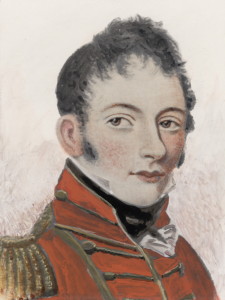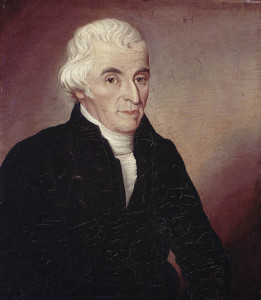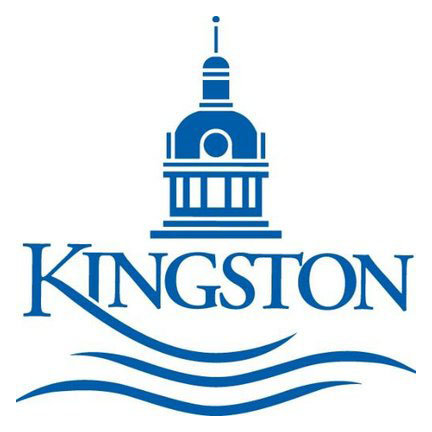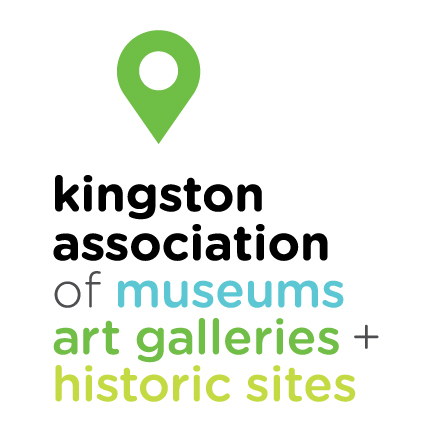Notable
Colonel Sir Richard Bonnycastle
b. 1791 (London, England), d. 1847, Royal Engineers, served in Nova Scotia in 1812 and with the British army that occupied parts of Maine in 1814. He later came to Kingston and finished the construction of Fort Henry. He commanded local troops during the 1837 rebellion and 1838 invasion scare, for which he was knighted. An author and artist, he was also bilingual. His burial location is unmarked although his stone marker survives.
- Excellent websites on Bonnycastle genealogy
- Dictionary of Canadian Biography (DCB) article by G.K. Raudzens)
- Link to the Image from the Toronto Public Library
- Burial register
Molly Brant (Tekonwatonti)
b. c1736 (Ohio), d. 1796, the influential matriarch of the Mohawks. She was the consort of Sir William Johnson and bore eight children by him. She and her brother Thayendanaga (Joseph Brant) influenced Mohawks and most other Iroquois to remain loyal to the Crown during the American Revolution. Molly Brant came to Kingston in 1783. The British government built her a stone house and paid her a pension. She was the only woman among the founding members of St. George’s Church. Her burial location is unmarked.
- Dictionary of Canadian Biography (DCB) article by Barbara Graymont
- Website
- Ontario Heritage Foundation Plaque
- Burial register
John Solomon Cartwright
b. 1804 (in Kingston), d. 1845 at Rockwood estate, Kingston, inherited both power and influence from his father the Honourable Richard Cartwright. His twin brother Robert David was a well-respected Anglican priest for whom St. Paul’s Church was erected as a memorial following his death in 1843. John Solomon Cartwright was trained as a lawyer and by 1834 had been appointed as a judge of the Midland District Court. He also had an extensive career in business, politics and land development, as well as being involved with the militia.
The Honourable Richard Cartwright
b. 1759 (in Albany), d. 1815, came to Kingston in 1784 or 1785. He was a victualler for the army, forwarder, ship owner, retailer, mill owner, distillery owner, land speculator, judge, Legislative Councillor, militia colonel and a warden at St. George’s Church. He was a man of great intellect who had a photographic memory, was a fair and honest businessman and a strong advocate of free trade with the United States.
Joseph Forsyth
b. c1760 (in Scotland), d. 1813, was a victualler for the army, brewery owner, land speculator, forwarder, retailer, justice of the peace, road commissioner, collector of customs and a warden at St. George’s Church.
Hugh Earl
b. c1765 (in Ayrshire, Scotland), d. 1841, commanded HMS Royal George and was commodore of the Provincial Marine. He led the attack on Sackets Harbor in 1814. His wife was Anne, a daughter of Sir William Johnson and Molly Brant (Tekonwatonti). Hugh and Anne Earl’s daughter, Jane Miller, was the last person to be buried in this cemetery. (1863) His burial register can be found here.
Captain Sir Robert Hall
b. 1778, d. 1818, was a Royal Navy officer who was the administrator of the Kingston Naval Dockyard and in charge of supplies and ship construction. He was knighted in 1816 and then became the commodore commanding British naval forces on the Great Lakes in 1818.
Robert Macaulay
b. 1744 (in Northern Ireland), d. 1800, came to Kingston in 1784. He was a merchant, businessman, land speculator and founding member and benefactor of St. George’s Church.
Thomas Markland
b. 1757 (in the Mohawk River valley), d. 1840, came to Kingston in 1784 and was a forwarder, merchant, land speculator, militia colonel and justice of the peace. He was interested in improving banking and transportation, was a founding member and warden of St. George’s Church but also supported building Presbyterian and Methodist churches in Kingston.
Neil McLean
Details of McLean’s early years are unclear but he came to Kingston as an assistant commissary and storekeeper when the Loyalist regiments were disbanded to settle at Cataraqui in 1783. As an early leader in Kingston, he held a number of government positions including Justice of the Peace, inspector for Loyalist land claims, member of the Land Board for the District of Mecklenburg, Judge of the Court of Common Pleas and later a Justice of the Court of Quarter Sessions. McLean died in Kingston and was buried in the Lower Burial Ground on 1 September 1795.
Peter Smith
b. 1752, d. 15 August 1826 in Kingston. Smith came from Vermont as a Loyalist and by 1791 he was established in Kingston as a businessman in the forwarding trade with extensive involvement in supplying the British army. Smith was involved in a variety of business interests including as an investor in the Frontenac, the first steamship (1816) on the Great Lakes.
Reverend Dr. John Stuart
b. 1740 (in Pennsylvania), d. 1811, was missionary to the Mohawks, who came to Kingston in 1785. He was the first Protestant clergyman in Ontario, founder and rector of St. George’s Church and started the first school in Kingston. Together with Thayendanaga (Joseph Brant) he translated the Gospel of St. Mark and the Catechism into the Mohawk language.
Reverend George Okill Stuart
b. 29 June 1776 at Fort Hunter (New York) in the Mohawk valley, to Reverend John Stuart and Jane Okill, d. 5 Oct. 1862 at Kingston. George Okill Stuart came with his family to Kingston in 1785. After a variety of educational opportunities, he was ordained as a deacon and then as a priest in the Anglican church in 1801, first in York and then later in Kingston in 1812 when he took over from his father. He remained in Kingston until his death in 1862 at age 86.
Hugh Christopher Thomson
b. 1791 in Kingston, d. there 23 April 1834, was first involved in the mercantile business but in 1819 he wound up these interests to become proprietor and editor of the Upper Canada Herald. This was a job in which he excelled so that by the mid-1820s the Herald had the largest circulation of all newspapers in Upper Canada. Thomson was elected as a moderate reformer in 1824 and remained as Kingston’s political representative for 10 years, his greatest political achievement being the establishment of the provincial penitentiary at Kingston.






